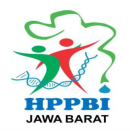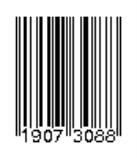Preferensi Media Tumbuh Tungau Penyebab Penyakit Krepes pada Jamur Kuping (Auricularia polythrica)
Abstract
Abstrak: Jamur Kuping (Auricularia polytrica) yang banyak dibudidayakan oleh petani jamur di Daerah Istimewa Yogyakarta sering terkendala oleh penyakit dikenal dengan nama setempat sebagai krepes. Penyakit ini disebabkan oleh organisme dari kelompok tungau (acarina). Identifikasi terhadap penyebab penyakit krepes di pertanian jamur Indonesia ini belum dilakukan secara komprehensif. Identifikasi terhadap tungau penyebab penyakit krepes membutuhkan teknik perbanyakan tungau yang tepat dimana informasi tentang media optimum pertumbuhan tungau menjadi dasar yang penting untuk mendukung teknik kultur tungau yang baik. Penelitian ini bertujuan untuk mempelajari medium optimum untuk perbanyakan kultur tungau. Penelitian ini menggunakan beragam bahan yang kemungkinan menjadi media preferensi tungau untuk tumbuh, baik pada uji medium invitro ataupun pada uji medium lapang (pada baglog jamur). Hasil penelitian menunjukkan bahwa tungau penyebab penyakit krepes pada jamur kuping lebih menyukai tempat hidup pada baglog yang sudah ditumbuhi oleh miselium jamur dan baglog yang sudah menghasilkan badan buah jamur. Hal ini terkait ketersediaan nutrisi yang dimiliki oleh miselium atau badan buah jamur yang telah tumbuh dalam media baglog.
Kata Kunci: tungau; krepes; medium, jamur kuping
Abstract: Wood ear mushrooms (Auricularia polythrica), that is commonly cultivated by mushroom farmers in the Special Region of Yogyakarta, is often plagued by a disease which has the local name : krepes. The group of mites (acarina) has been declared as the causal agent of krepes disease. Identification of the causes of crepes in Indonesian mushroom farming has not been carried out comprehensively. Identification of mites that cause krepes requires proper propagation techniques where the optimum growth medium serves as a basis for supporting mites culture techniques. This research aims to study the optimum medium for mite culture propagation. A variety of materials that are likely to be the preferred media for mites to grow were used, either on the invitro test or field test (mushroom baglog). Results showed that the mites prefer to live on the mushroom baglogs which has been covered by fungal mycelium and baglogs which has produced mushroom bodies. This growth preference is suggested to be related to the availability of nutrients from both mycelium and basidiocarp that is grown on the baglog..
Keywords: mites; krepes; medium, wood ear mushroom
Full Text:
PDFReferences
Duek, L., Kaufman, G., Palevsky, E. and Berdicevsky, I. 2001. Mites in fungal cultures. Mycoses 44, 390–394. doi:10.1046/j.1439-0507.2001.00684.x
Erban, T., Rybanska, D. and Hubert, J. (2015). Population growth of the generalist mite Tyrophagus putrescentiae (Acari:Acaridida) following adaptation to high or low fat and high or low protein diets and the effect of dietary switch. Environmental Entomology, 44, 1599–1604. doi:10.1093/ee/nvv129
Hadiyanti, N., Lisanty, N., dan Aji, S.B. 2020. Kajian Produksi Jamur Kuping (Auricularia auriculajudae) pada Berbagai Komposisi Media Tanam. Jurnal Agrinika, Vol. 4 No. 1, Maret 2020, 1-43
Harjaka, T., Suryanti, and Pratama, S. W. 2010. Biology and Ecology of Mite Attacking Mushroom in Yogyakarta. Proceeding of International Conference on Food Safety & Food Security. Yogyakarta: 1-2 Desember 2010. Hal. 203-207.
Kheradmand, K., Kamali, K., Fathipour, Y., and Goltapeh, E.M. 2007. Development, Life Table and Thermal Requirement of Tyrophagus putrescentiae (Astigmata: Acaridae) on Mushrooms. Journal of Stored Product Research, 43, 276-281. doi:10.1016/j.jspr.2006.06.007
Matsumoto, K., Okamoto, M, and Horikawa, M. 1998. The Effect of the Different Environmental Condition on the Dispersion of Grain and House Dust Mite. Medical Entomology and Zoology 49, 291-300.
Parjimo, dan Andoko, A. 2007. Budidaya Jamur (Jamur Kuping, Jamur Tiram dan Jamur Merang. AgroMedia Pustaka. Jakarta
Priya, R.U., Geetha, D., and Darshan, S. 2016. Biology and Cultivation of Black Ear Mushroom – Auricularia spp. Advances in Life Sciences 5(22), 10252-10254
Qu, S. X., and Li, H. P. 2015. Effect of Different Edible Mushroom Host on the Development, Reproduction and Bacterial Community of Tyrophagus putrescentiae (Schrank). Journal of Stored Product Research, 61, 70-75.
Raypuriya, N. Singh, Y., Wasnikar, A.R., and Prajapati, S. 2018. Insect Pest and Disease Management in Mushroom. Rashtriya Krishi, Vol. 13 (2), December 2018, 23-35.
Ree, Han-II and Lee In-Young. 1997. Development of Mass Rearing Technique of Tyrophagus putrescentiae (Acari: Acaridae) Found in House Dust. The Korean Journal of Parasitology, 35 (3), 149-154.
Rozej, E., Witalinski, W., Szentgyorgyi, H., Wantuch, M., Moron,D. and Woyciechowski, M. (2012). Mite species in habiting commercial bumblebee (Bombus terrestris) nestsin Polish green houses. Experimental Applied Acarology 56, 271–282. doi: 10.1007/s10493-012-9510-8
Sanchez-Ramos, I and Castanera, P. 2001. Development and survival of Tyrophagus putrescentiae (Acari: Acaridae) at Constant Temperature. Environmental Entomology 30, 1082-1089.
Smrz, J. (1989). Internal anatomy of Hypochthonius rufulus (Acari: Oribatida). Journal of Morphology. 200, 215–230.doi:10.1002/jmor.1052000210
Sumartini S, dan Kantasubrata J. 1992. Analisis Proksimat 1 dan 2. Kursus Teknik Kimia Pangan. P3KT-LIPI : Bandung.
Suryanti, dan Harjaka, T. 2007. Kisaran Inang Hama Tungau. Jurnal Perlindungan Tanaman Indonesia, 13, 136-141.
Refbacks
- There are currently no refbacks.
Copyright (c) 2021 Quagga: Jurnal Pendidikan dan Biologi

This work is licensed under a Creative Commons Attribution-NonCommercial-ShareAlike 4.0 International License.
QUAGGA : Jurnal Pendidikan dan Biologi
ISSN 1907-3089 (print), ISSN 2651-5869 (online)
Organized by Biological Education Study Program, Faculty of Teachers Training and Education, Universitas Kuningan, Indonesia.
Website : https://journal.uniku.ac.id/index.php/quagga/index
Email : [email protected]
Address : Jalan Cut Nyak Dhien No.36A Kuningan, Jawa Barat, Indonesia.

Ciptaan disebarluaskan di bawah Lisensi Creative Commons Atribusi-BerbagiSerupa 4.0 Internasional.






